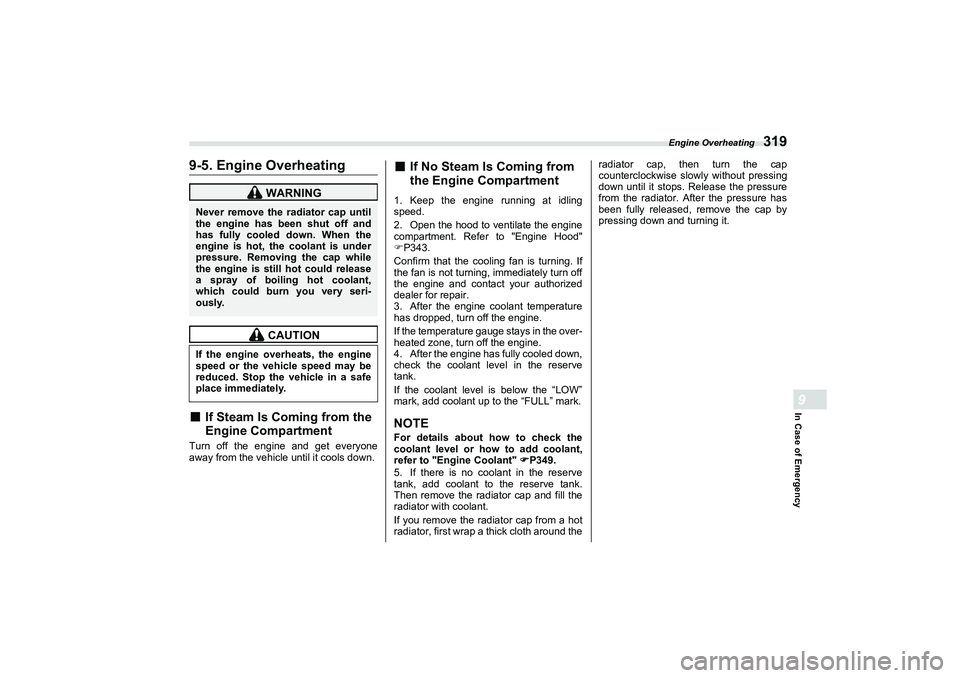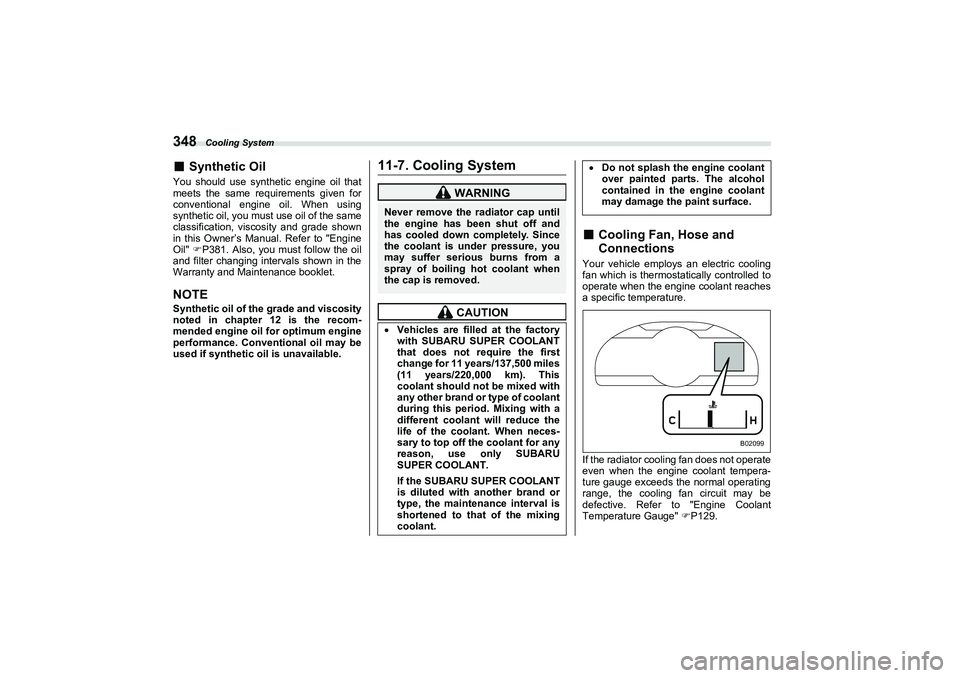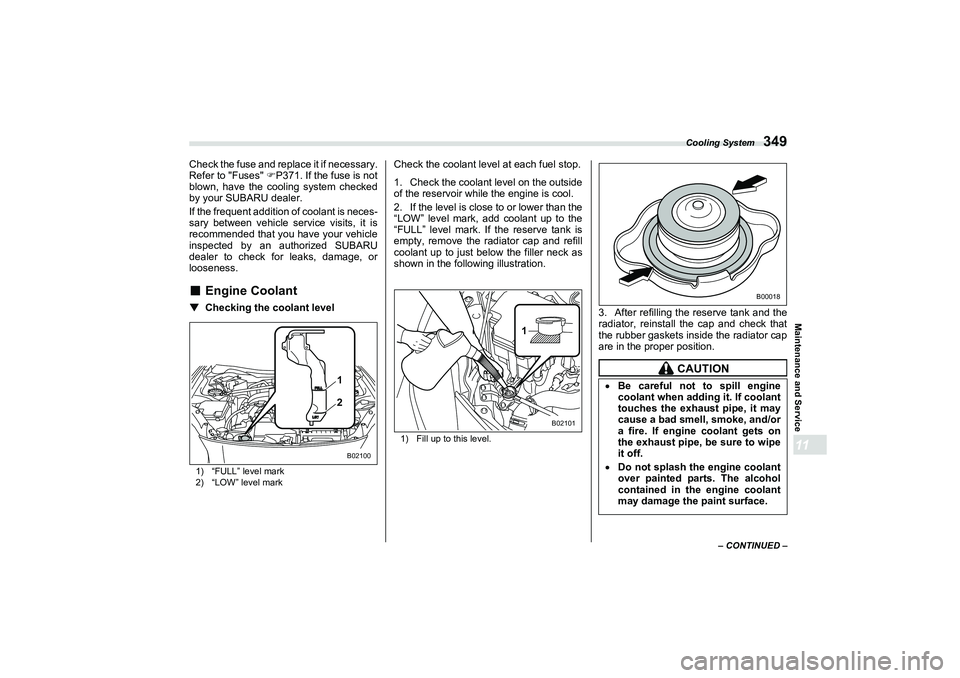Page 325 of 432

Engine Overheating
319
In Case of Emergency9
9-5. Engine Overheating■
If Steam Is Coming from the
Engine Compartment
Turn off the engine and get everyone
away from the vehicle until it cools down.
■
If No Steam Is Coming from
the Engine Compartment
1. Keep the engine running at idling
speed.
2. Open the hood to ventilate the engine
compartment. Refer to "Engine Hood"
P343.
Confirm that the cooling fan is turning. If
the fan is not turning, immediately turn off
the engine and contact your authorized
dealer for repair.
3. After the engine coolant temperature
has dropped, turn off the engine.
If the temperature gauge stays in the over-
heated zone, turn off the engine.
4. After the engine has fully cooled down,
check the coolant level in the reserve
tank.
If the coolant level is below the “LOW”
mark, add coolant up to the “FULL” mark.NOTEFor details about how to check the
coolant level or how to add coolant,
refer to "Eng ine Coolant"
P349.
5. If there is no coolant in the reserve
tank, add coolant to the reserve tank.
Then remove the radiator cap and fill the
radiator with coolant.
If you remove the radiator cap from a hot
radiator, first wrap a thick cloth around the radiator cap, then turn the cap
counterclockwise slowly without pressing
down until it stops. Release the pressure
from the radiator. After the pressure has
been fully released, remove the cap by
pressing down and turning it.
WARNING
Never remove the radiator cap until
the engine has been shut off and
has fully cooled down. When the
engine is hot, the coolant is under
pressure. Removing the cap while
the engine is still hot could release
a spray of boiling hot coolant,
which could burn you very seri-
ously.
CAUTION
If the engine overheats, the engine
speed or the vehicle speed may be
reduced. Stop the vehicle in a safe
place immediately.
B�5�=�B�8.�E�R�R�N 31�� ページ 2021年7月5日 月曜日 午後>1時>1>1分
Page 351 of 432
Engine Compartment Overview
345
Maintenance and Service11
11-5. Engine Compartment Overview
19
3
2
11
8
10
4
6
7
5
B02096
1) Battery (page 370)
2) Clutch fluid reservoir (MT models)(page 354)
3) Brake fluid reservoir (page 353)
4) Windshield washer tank (page 366)
5) Engine oil filler cap (page 346)
6) Air cleaner case (page 350)
7) Engine oil filter (page 347)
8) Engine oil level gauge (page 346)
9) Engine coolant reservoir (page 349)
10) Radiator cap (page 349)
11) Main fuse box (page 371)
B�5�=�B�8.�E�R�R�N 345 ページ 2021年7月5日 月曜日 午後>1時>1>1分
Page 354 of 432

Cooling System
348■
Synthetic Oil
You should use synthetic engine oil that
meets the same requirements given for
conventional engine oil. When using
synthetic oil, you must use oil of the same
classification, viscosity and grade shown
in this Owner’s Manual. Refer to "Engine
Oil" P381. Also, you must follow the oil
and filter changing intervals shown in the
Warranty and Maintenance booklet.NOTESynthetic oil of the grade and viscosity
noted in chapter 12 is the recom-
mended engine oil for optimum engine
performance. Conventional oil may be
used if synthetic oil is unavailable.
11-7. Cooling System
■
Cooling Fan, Hose and
Connections
Your vehicle employs an electric cooling
fan which is thermostatically controlled to operate when the engine coolant reaches
a specific temperature.
If the radiator cooling fan does not operate
even when the engine coolant tempera-
ture gauge exceeds the normal operating
range, the cooling fan circuit may be
defective. Refer to "Engine Coolant
Temperature Gauge" P129.
WARNING
Never remove the radiator cap until
the engine has been shut off and
has cooled down completely. Since
the coolant is under pressure, you
may suffer serious burns from a
spray of boiling hot coolant when
the cap is removed.
CAUTION
Vehicles are filled at the factory
with SUBARU SUPER COOLANT
that does not require the first
change for 11 years/137,500 miles
(11 years/220,000 km). This
coolant should not be mixed with
any other brand or type of coolant
during this period. Mixing with a
different coolant will reduce the
life of the coolant. When neces-
sary to top off the coolant for any
reason, use only SUBARU
SUPER COOLANT.
If the SUBARU SUPER COOLANT
is diluted with another brand or
type, the maintenance interval is
shortened to that of the mixing
coolant.
Do not splash the engine coolant
over painted parts. The alcohol
contained in the engine coolant
may damage the paint surface.
B02099
B�5�=�B�8.�E�R�R�N 34�� ページ 2021年7月5日 月曜日 午後>1時>1>1分
Page 355 of 432

Cooling System
349
Maintenance and Service11
– CONTINUED –
Check the fuse and replace it if necessary.
Refer to "Fuses" P371. If the fuse is not
blown, have the cooling system checked
by your SUBARU dealer.
If the frequent addition of coolant is neces-
sary between vehicle service visits, it is
recommended that you have your vehicle
inspected by an authorized SUBARU
dealer to check for leaks, damage, or
looseness.■
Engine Coolant
▼
Checking the coolant level1) “FULL” level mark
2) “LOW” level mark
Check the coolant level at each fuel stop.
1. Check the coolant level on the outside
of the reservoir while the engine is cool.
2. If the level is close to or lower than the
“LOW” level mark, add coolant up to the
“FULL” level mark. If the reserve tank is
empty, remove the radiator cap and refill
coolant up to just below the filler neck as
shown in the following illustration.
1) Fill up to this level.
3. After refilling the reserve tank and the
radiator, reinstall t he cap and check that
the rubber gaskets in side the radiator cap
are in the proper position.
12B02100
1
B02101
CAUTION
Be careful not to spill engine
coolant when adding it. If coolant
touches the exhaust pipe, it may
cause a bad smell, smoke, and/or
a fire. If engine coolant gets on
the exhaust pipe, be sure to wipe
it off.Do not splash the engine coolant
over painted parts. The alcohol
contained in the engine coolant
may damage the paint surface.
B00018
B�5�=�B�8.�E�R�R�N 34�� ページ 2021年7月5日 月曜日 午後>1時>1>1分